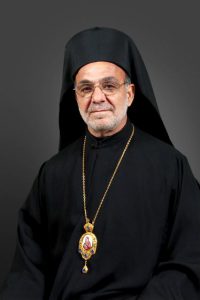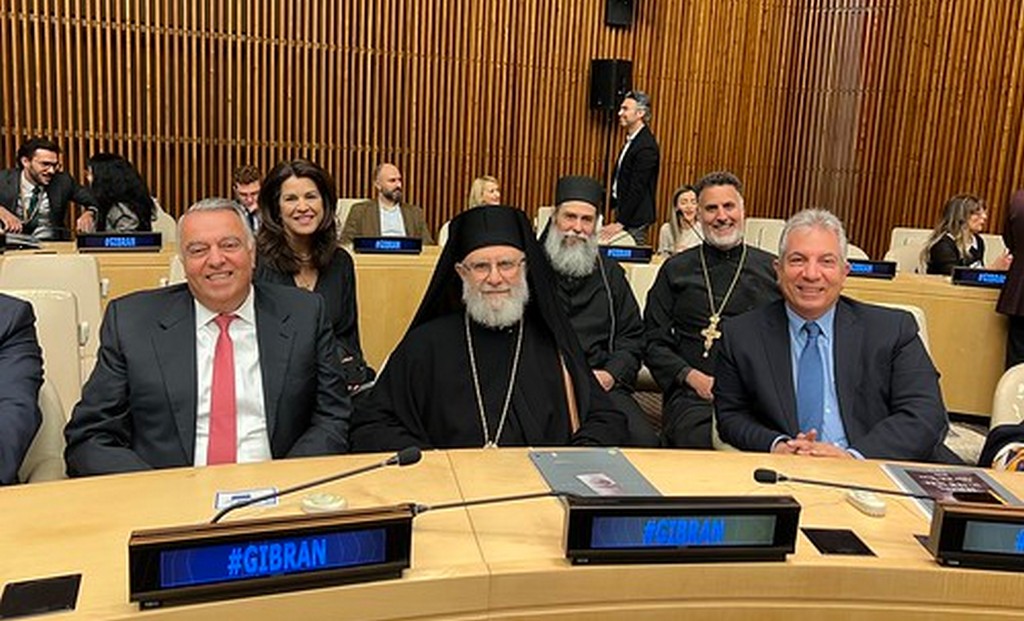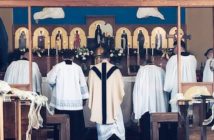
His Grace, the Right Reverend Thomas (Joseph)
Source: Solia – The Herald
by Bishop THOMAS (Joseph) and Peter Schweitzer as presented at the Church of St Patrick, Warrenton, VA
There is a common tendency in our Western culture to equate the One, Holy, Catholic, and Apostolic Orthodox Church to corporations which are institutional structures that are driven by commerce and production. In so doing, we equate bishops with CEOs and priests and deacons as mid-level managers. Accordingly, parish councils operate as ecclesiastical boards of directors, bishops operate at the pleasure of the parish councils, and priests and deacons implement the directives and goals set forth by the councils. The adoption of this corporate model for the Church can be enticing at times since it is efficient, goal-oriented, and produces tangible results. It is especially tempting when a parish is intent on building a new temple, school, or other worthy project. However, it’s a model that betrays the original nature and purpose of the Church according to the mind of Christ (1Cor. 2:16). While the corporate model is a necessary vehicle for commerce and economic vitality, it has no place in the Church founded by Christ. Since it is impossible to envisage the episcopal office as well as the clerical ranks of priest and deacon outside of the context of the Church, it is first necessary to examine the nature of the Church before we reflect upon the office of bishop and how he relates to the clerical orders and the laity.
The Sacred Scriptures and the holy fathers provide us with the true model of the Church which is the Ark of Salvation. This notion of the Church as the Ark of Salvation is prefigured in the Old Testament figures of Noah and Moses. Saint Cyprian of Carthage affirms this in stating, “the one ark of Noah was a type of the one Church.”[i] Father Patrick Henry Reardon notes that this symbolism is found in Noah’s ark as well as the infant Moses floating on the Nile River. “The root of such symbolism is found in the Old Testament’s own portrayal of Noah’s ark. Genesis calls it a tevah, a word used in only one other place in the Hebrew Scriptures, namely, to designate the little box in which the infant Moses floated on the Nile. Indeed, the juxtaposition of the two stories seems clearly intentional if we examine the manifest similarities between them. First, in respect to both Noah and Moses, the tevah is a floating container that preserves life from the peril of drowning. That is to say, the threat comes from water. Second, in each case the container is daubed with pitch to keep out the threatening water (6:14; Exodus 2:3). Third, both stories contribute to the ongoing biblical theme of God’s deliverance of His servants in times of crisis. There is an even subtler element here, however. The word tevah is not Hebrew; it is Egyptian, in which language it may designate a box, a chest, even a coffin. Its use in only these two biblical passages cries out for an explanation. I can think of a single reasonable answer: Namely, that the biblical author had in mind to tie these two accounts together in a very explicit way, so that the correspondence between them would be unmistakable.”[ii]
This imagery was not lost on the holy fathers who employed it in describing the Church founded by Christ. Saint Cyprian of Carthage writes, “If anyone who was outside the ark could have escaped, so would he escape who was outside the Church.”[iii] In the fourth century, Saint John Chrysostom continues the use of this imagery in his Homily on Lazarus: “The narrative of the Flood is a mystery, and its details are a type of things to come. The ark is the Church; Noah is Christ; the dove, the Holy Spirit; the olive branch, the divine goodness. As in the midst of the sea, the ark protected those who were within it, so the Church saves those who are saved.”[iv] The Church is the ark, as real and concrete as an ark of wood and as essential for salvation from the floods of this world as a ship is for those drowning at sea.[v]
As the ark of salvation, prefigured in the Old Testament and fully realized in the New Testament and the life of the Church, the one, holy, catholic, and apostolic Church enjoys a character which no human institution may claim. The Church is theanthropic. This is a term that is central to Orthodoxy for it undergirds the manner in which we speak about God, understand the Church, and most importantly, engage in the spiritual struggle. Unlike the West which relies on philosophical systems of thought, the East, specifically the Orthodox Church, employs theanthropicity to orient and provide the proper context for everything pertaining to the history of salvation. Simply put, the term refers to the union of God and man first and foremost, in the Incarnation of Jesus Christ and following directly from that to the Church and the mission of the Church – the salvation of mankind. Theanthropicity implies an understanding of man’s existence and salvation in relation to His Creator and Savior. Just as Noah and Moses relied upon God to make manifest the divine will, so too the Church acknowledges this synergeia between God and man to preach the Good News of salvation. God must act first, and this must be acknowledged. We do not and cannot save ourselves. However, God’s action must be reciprocated by our response. This notion has been relegated to the background in the West. God alone can satisfy the unquenchable human desire for life without end. This is also the reason why the Church is principally the Divine Liturgy, and not a worldly or social organization.
As Saint Justin Popovic writes,
“The attributes of the Church are innumerable because her attributes are actually the attributes of the Lord Christ, the God-man, and, through Him, those of the Triune Godhead. However, the holy and divinely wise fathers of the Second Ecumenical Council, guided and instructed by the Holy Spirit, reduced them in the ninth article of the Symbol of Faith to four — I believe in one, holy, catholic, and apostolic Church. These attributes of the Church — unity, holiness, catholicity (sobornost), and apostolicity — are derived from the very nature of the Church and of her purpose. They clearly and accurately define the character of the Orthodox Church of Christ whereby, as a theanthropic institution and community, she is distinguishable from any institution or community of the human sort.
Just as the Person of Christ the God-man is one and unique, so is the Church founded by Him, in Him, and upon Him. The unity of the Church follows necessarily from the unity of the Person of the Lord Christ, the God-man. Being an organically integral and theanthropic organism unique in all the world, the Church, according to all the laws of Heaven and earth, is indivisible. Any division would signify her death. Immersed in the God-man, she is first and foremost a theanthropic organism, and only then a theanthropic organization. In her, everything is theanthropic: nature, faith, love, baptism, the Eucharist, all the holy mysteries and all the holy virtues, her teaching, her entire life, her immortality, her eternity, and her structure.
Yes, yes, yes; in her, everything is theanthropically integral and indivisible Christification, sanctification, deification, Trinitarianism, salvation. In her everything is fused organically and by grace into a single theanthropic body, under a single Head — the God-man, the Lord Christ. All her members, though as persons always whole and inviolate, yet united by the same grace of the Holy Spirit through the holy mysteries and the holy virtues into an organic unity, comprise one body and confess the one faith, which unites them to each other and to the Lord Christ.
The Christ-bearing apostles are divinely inspired as they announce the unity and the uniqueness of the Church, based upon the unity and uniqueness of her Founder — the God-man, the Lord Christ, and His theanthropic personality. Like the holy apostles, the holy fathers and the teachers of the Church confess the unity and uniqueness of the Orthodox Church with the divine wisdom of the cherubim and the zeal of the seraphim. Understandable, therefore, is the fiery zeal which animated the holy fathers of the Church in all cases of division and falling away and the stern attitude toward heresies and schisms. In that regard, the holy ecumenical and holy local councils are preeminently important. According to their spirit and attitude, wise in those things pertaining to Christ, the Church is not only one but also unique. Just as the Lord Christ cannot have several bodies, so He cannot have several Churches. According to her theanthropic nature, the Church is one and unique, just as Christ the God-man is one and unique.”[vi]
This theanthropic character of the Church not only sets her apart but provides us with indications concerning how we relate to one another within the Church. Specifically, it gives us insight into how the bishop, the icon of Christ, is to relate to priests, deacons, and laity. St. Ignatius the God-Bearer, Bishop of Antioch, links the Bishop and Jesus Christ together to such a degree that everything which happens to a visible Bishop of the Church is attributed and ascribed to the invisible Bishop, Christ our Savior.
The following is precisely what the Saint says: “For the honor, therefore, of Him Who desired us, it is right that we obey (the Bishop) without any hypocrisy; for a man does not merely mislead this Bishop who is seen, but seeks to deceive Him Who is invisible.”[vii]
In a spiritual talk entitled “The Place of the Bishop in the Orthodox Church”, Archimandrite Cyprian (now Bishop) asked, “What is the Church?”
- The Church is the Assembly of the People of God for the celebration of the Mystery of the Divine Eucharist, wherein the local Church actually becomes and is revealed as the Body of Christ, as a Theandric organism, in which the Holy Trinity dwells.
- The visible center and head of the Eucharistic Assembly is the Bishop: It is he who leads the Assembly and preaches the word of God; it is he who offers the Eucharist, as an Icon of Christ, the Great High Priest, and as the one who presides in the place of God, according to St. Ignatius of Antioch.
- In the early Church, only the Bishop offered the Divine Eucharist in each local Church; that is, there was only one Eucharist, and this was centered on the Bishop.
- The Bishop, when he offers the Divine Eucharist, offers Christ in His wholeness, imparting the Holy Mysteries to the Faithful with his own hands; in ancient times, the People of God partook of Christ only from the living Icon of Christ, the Bishop.
- Therefore, the Bishop not only embodies the local Church, but also expresses in time and space the Catholic Church, that is, the whole Church; for that which embodies Christ in His wholeness, and wherein one receives Christ in His wholeness, is that which embodies the One, Holy, Catholic, and Apostolic Church. Wherever Jesus Christ is, says St. Ignatius, there is the Catholic Church.
- For precisely this reason, when one is united with the Bishop in the Mystery of the Divine Eucharist, then he is also united with the Catholic Church. St. Cyprian f Carthage emphasizes this ecclesiological truth in the following striking terms: The Bishop is in the Church and the Church in the Bishop; and if one is not in communion with the Bishop, he is not in the Church.”[viii]
The synergy between the laity, the priests and deacons, and the bishop is required if we are to imitate the theanthropic quality of the Lord Jesus. As Christ was obedient to His Father, so too we have a duty to be obedient and cooperate with the bishop in imitation of Christ. Since the relationship between the members of the Church and the bishop is a necessary one, it is an ascetic practice which will bear fruit unto eternal life.
This apostolic teaching, consistently confirmed by the holy fathers, is grounded in the theanthropic nature of the Church. Without it, the divine-human character of the episcopal office would be lost. As the icon of Christ, the bishop imitates his master as the minister of conciliation in the Church, uniting all those desirous of salvation in Christ. Drawing upon this parallel, the bishop is to be obedient unto death to the teachings of Christ and His Church in the service of love to His people. If there is one word that may encapsulate the relationship of the bishop to the priests, deacons, and laity he serves, it is love. “For God so loved the world that he gave his only begotten Son, that whosoever believeth in him should not perish, but have everlasting life.” (John 3:16)
Perhaps this can be no better exemplified than in the life of our father among the Saints Raphael Hawaweeny of Brooklyn. Saint Raphael’s entire life manifested the love of Christ for His people. As Christ’s love knew no boundaries, Saint Raphael’s holy zeal knew no end. Like the saintly hierarchs Saint John of San Francisco and Saint Nektarios of Aegina, Saint Raphael’s love for his people was manifest in his tireless apostolic efforts, his scholarship, and his pious life. As Saint Nektarios and Saint John are venerated in their blessed repose by the faithful from various backgrounds, cultures, and languages, so too Saint Raphael is fondly recalled by Orthodox Christians of different jurisdictions and languages. The similarities concerning the three sainted bishops do not end there. All three hierarchs toiled in foreign lands, demonstrated unquestioning obedience to their superiors even in trying circumstances, and suffered for the sake of the Gospel. As Father David Bleam notes, “When Dr. Ibrahim Arbeely and the Syrian Benevolent Society asked for Fr. Raphael Hawaweeny to be sent to Brooklyn, NY to minister to them, Fr. Raphael was being asked to leave the Kazan Theological Academy in Imperial Russia. He was being asked to leave the glorious splendor of czarist, Orthodox Russia to go to a non-Orthodox country. He had spent all his years surrounded by Orthodox culture, growing up in Damascus, Syria and being educated in Halki. Now he was being asked to go to a religiously foreign culture here in America. He had been surrounded by the glories of Orthodox architecture, art, liturgical music, and monastic piety. Now he was being asked to go where there was no monastic life and very few Orthodox Churches.”[ix] And yet, he did this with apostolic zeal in obedience to His Lord Jesus Christ.
Saint Raphael “exemplified the image of a truly traditional Orthodox bishop. He received the faith from his forefathers and he sought faithfully to hand that faith over to his spiritual children. He was a great man of prayer. He loved and lived the liturgical life of the Church, and it was his spiritual support. He was not an innovationist; he did not change anything. He brought to his pastoral work no agenda other than to be faithful to the charge which he had received. It was the people he served who consumed his every thought and every scheme. How to reconcile enemies? How to restore the lapsed? How to raise the children? How to plant a mission? How to educate a priest? The legacy of his accomplishments is outstanding: he founded thirty parish churches, authored or translated fourteen books, including both the Small and the Great Euchologion, founded St. Nicholas Cathedral in Brooklyn, created and authored many articles in The WORD. But these accomplishments do not reveal the true sanctity of his soul nor do they give us the measure of the man. These are to be found rather in the lives of the people he led to Christ and His Church. The thousands who attended his funeral and paid their last respects all recognized in St. Raphael the image of the God he loved and served. Like his Chief Shepherd, St. Raphael laid down his life for his sheep. Like the great pastor, the Apostle Paul, he made up in his body that which was lacking in the sufferings of Christ (Colossians 1:24). He was not a hireling; having loved his own, he loved them to the end. It is this love which united him to God, and it is this love which unites him to us, his spiritual children. It is this love which sanctified him, and it is this love in which he dwells in the heavenly Kingdom. The words of our venerable and God-bearing Father John Climacus find their embodiment in St. Raphael: ‘Love grants prophecy, miracles. It is an abyss of illumination, a fountain of fire, bubbling up to inflame the thirsty soul. It is the condition of angels and the progress of eternity’.”[x]
In this brief portrait of Saint Raphael of Brooklyn, we have the ideal of a bishop and how he relates to his flock. Demanding strict asceticism from himself, he was gentle and loving with his clergy and the many laity who sought his counsel and solace. As a true shepherd of Christ’s flock, he was vigilant in protecting his spiritual children from false teachings and error. At the time of his repose, Saint Raphael had founded 30 Orthodox churches spanning the United States and including Canada and Mexico.
As Saint Raphael has taught us, the bishop is to serve the flock of Christ as its spiritual father, collaborating with the priests and deacons, by rightly dividing the word of truth. (2 Tim 2:15)
The theanthropic nature of the Church guarantees its authenticity, indivisibility, and its mission – the eternal salvation of Christ’s flock. Just as Noah’s ark and the Mosaic tevah ensured their safety from physical peril as typological structures, the Orthodox Church guides and protects those who desire eternal salvation. The role of the bishop is to preserve the integrity of the salvific vessel and proclaim through his life and preaching the divine economy in the midst of turbulent seas. The bishop does not act alone, just as salvation is not achieved through God’s intervention solely but requires the active response and participation of man; so too, the Church requires a synergeia between the bishop, his priests and deacons, and the laity. The Lenten Triodion perfectly summarizes this in the vesperal stichera of the Second Sunday of Great Lent celebrating the memory of Saint Gregory Palamas:
“What hymns of praise shall we sing in honor of the holy bishop? He is the trumpet of theology, the herald of the fire of grace, the honored vessel of the Spirit, the unshaken pillar of the Church, the great joy of the inhabited earth, the river of wisdom, the candle-stick of the light, the shining star that makes glorious the whole creation.
What words of song shall we weave as a garland, to crown the holy bishop? He is the champion of true devotion and the adversary of ungodliness, the fervent protector of the Faith, the great guide and teacher, the well-tuned harp of the Spirit, the golden tongue, the fountain that flows with waters of healing for the faithful, Gregory the great and marvelous.
With what words shall we who dwell on earth praise the holy bishop? He is the teacher of the Church, the herald of the light of God, the initiate of the heavenly mysteries of the Trinity, the chief adornment of the monastic life, renowned alike in action and in contemplation, the glory of Thessalonica; and now he dwells in heaven with the great and glorious martyr Demetrius, whose relics flow with holy oil.
Inspired by the divine Spirit, as a winged angel thou hast come to the aid of the pious Emperor, fighting against the foolish-minded Barlaam, who in his madness blasphemed against the glory of God; and thou hast justly gained the victory over him.
Wholly filled with heavenly wisdom, O glorious saint, thou hast shone as a light in the world, teaching the doctrines of Orthodoxy. In thy love for true wisdom thou hast conceived the fear of God within thy heart, and given birth to the words of the Spirit.”[xi]
+Bp. THOMAS
[i] Cyprian of Carthage, Letters, 75:2 (New Advent) Translated by Robert Ernest Wallis. From Ante-Nicene Fathers, Vol. 5. Edited by Alexander Roberts, James Donaldson, and A. Cleveland Coxe. (Buffalo, NY: Christian Literature Publishing Co., 1886.) Revised and edited for New Advent by Kevin Knight, http://www.newadvent.org/fathers/050675.htm. [ii] Patrick Henry Reardon, Creation and the Patriarchal Histories (Ben Lomond, CA: Conciliar Press Ministries), p. 58-59. [iii] Cyprian, On the Unity of the Catholic Church, 6 (New Advent) Translated by Robert Ernest Wallis. From Ante-Nicene Fathers, Vol. 5. Edited by Alexander Roberts, James Donaldson, and A. Cleveland Coxe. (Buffalo, NY: Christian Literature Publishing Co., 1886.) Revised and edited for New Advent by Kevin Knight, http://www.newadvent.org/fathers/050701.htm. [iv] John Chrysostom, Homily on Lazarus 6. [v] Hieromonk Alexios Karakallinos, “Contours of Conversion and the Ecumenical Movement”, a talk presented at the September, 2004 conference “Ecumenism: Origins, Expectations, Disenchantment”, sponsored by the School of Pastoral Theology, The Aristotelian University, Thessaloniki, Greece, http://orthodoxinfo.com/inquirers/fralexistalk.aspx. [vi] Justin Popovic, Originally published in Orthodox Life, vol. 31, no. 1 (Jan.-Feb., 1981), pp. 28-33. Translated by Stephen Karganovic from The Orthodox Church & Ecumenism (in Serbian) by Archimandrite Justin (Popovich) (Thessalonica: Chilandar Monastery, 1974), pp. 64-74. [vii] St. Ignatios, Patrologia Græca, Vol. V, col. 665A (Epistle to the Magnesians, III.2), http://orthodoxinfo.com/praxis/bishop_place.aspx. [viii] Archimandrite Cyprian, “The Place of the Bishop in the Orthodox Church”, from Orthodox Tradition, Vol. XVI, No. 3&4, pp. 8-17. Translated from the Greek and originally taken from an address delivered by Father (now Bishop) Cyprian of the Holy Monastery of Sts. Cyprian and Justina in Fili, Greece, on October 6, 1997 (Old Style), at the annual convocation (held that year at the Novotel Convention Center in Athens) in honor of the Name Day of Metropolitan Cyprian of Oropos and Fili, http://orthodoxinfo.com/praxis/bishop_place.aspx. [ix] Fr. David Bleam, “St. Raphael of Brooklyn”, http://standrewpns.org/sermons-by-fr-david-bleam/st-raphael-of-brooklyn/. [x] http://www.antiochian.org/life-our-father-among-saints-raphael-hawaweeny [xi] Trans. by Mother Mary and Arch. Kallistos Ware, “The Lenten Triodion”, Vespers for the Second Sunday of Great Lent, pp. 314-15 (South Canaan, PA: St. Tikhon’s Seminary Press, 2002).


